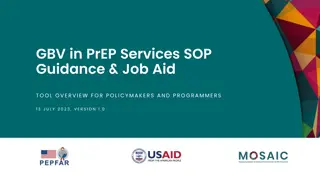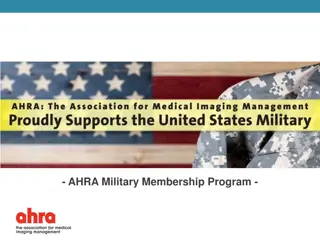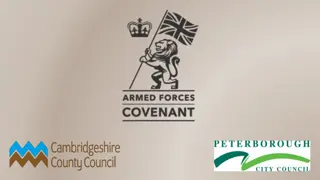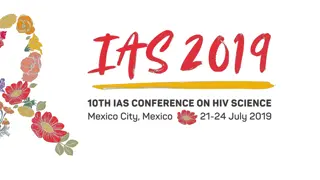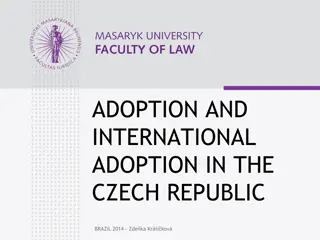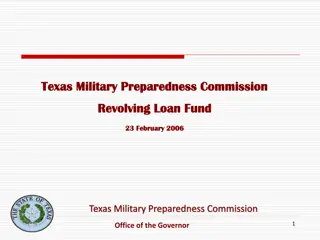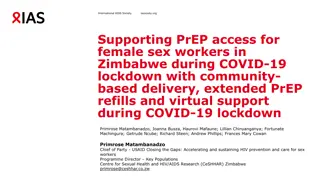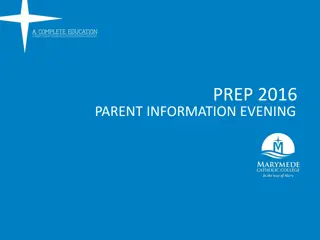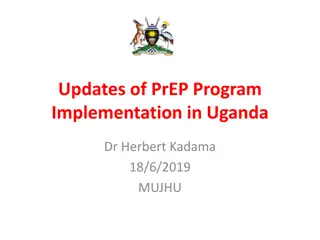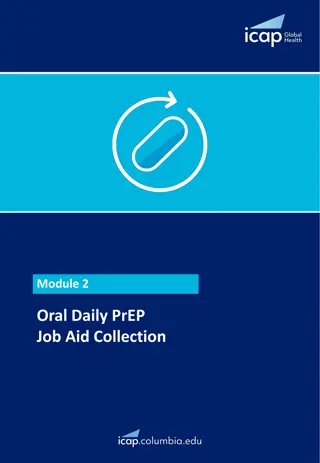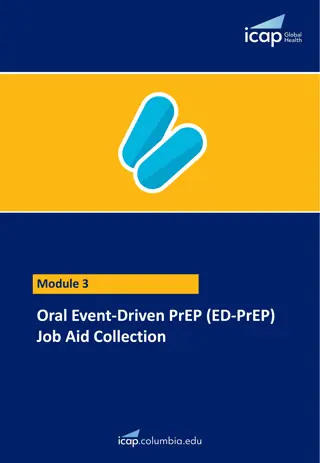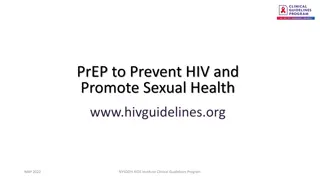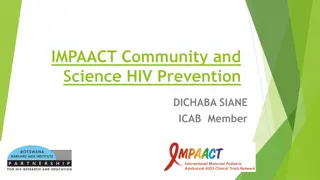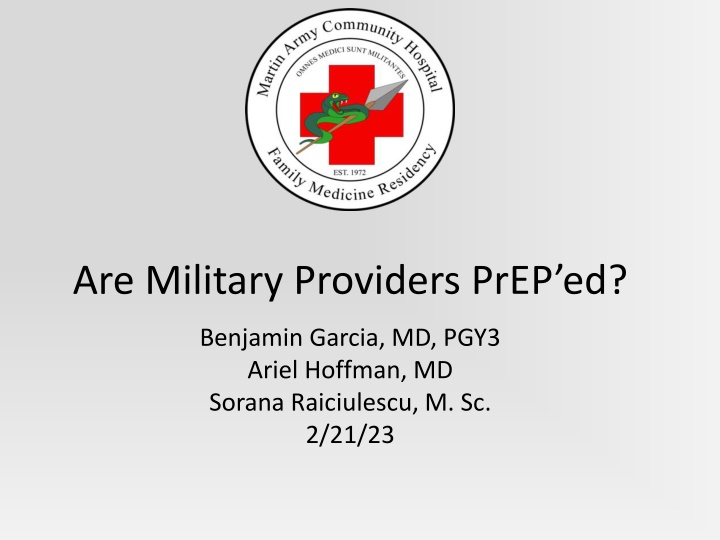
Military PrEP Adoption and Effectiveness
Extensive data on HIV screening and prevention strategies within the United States Military. Highlights the utilization and efficacy of HIV Pre-Exposure Prophylaxis (PrEP) among service members. Insights from studies on PrEP coverage by Tricare and implementation rates among military healthcare providers.
Download Presentation

Please find below an Image/Link to download the presentation.
The content on the website is provided AS IS for your information and personal use only. It may not be sold, licensed, or shared on other websites without obtaining consent from the author. If you encounter any issues during the download, it is possible that the publisher has removed the file from their server.
You are allowed to download the files provided on this website for personal or commercial use, subject to the condition that they are used lawfully. All files are the property of their respective owners.
The content on the website is provided AS IS for your information and personal use only. It may not be sold, licensed, or shared on other websites without obtaining consent from the author.
E N D
Presentation Transcript
Are Military Providers PrEPed? Benjamin Garcia, MD, PGY3 Ariel Hoffman, MD Sorana Raiciulescu, M. Sc. 2/21/23
Disclosures The views and statements in the presentation are solely from the investigators. They do not represent the opinions or positions of the Department of Defense or the United States Army. The investigators have no financial disclosures.
HIV and the United States Military Extensive screening programs Goal of screening Incidence of HIV in the United States Military New HIV Diagnosis in United States Military, 2017-2021 317 313 309 275 237 2017 2018 2019 2020 2021
HIV and the United States Military Extensive screening programs Goal of screening Incidence of HIV in the United States Military New HIV Diagnosis in United States Military, 2017-2021 433 New HIV Infections JAN21 JUL22 317 313 309 275 237 2017 2018 2019 2020 2021
Active Management of HIV Prevention HIV HIV Screening Prevention Identify individuals with high-risk sexual behavior Counseling on risk reduction methods Offering medication proven to decrease transmission of HIV
HIV Pre-Exposure Prophylaxis (PrEP) Highly effective at reducing HIV Covered by Tricare
HIV Pre-Exposure Prophylaxis (PrEP) Highly effective at reducing HIV Covered by Tricare 2018 Study 60% by infectious disease providers
HIV Pre-Exposure Prophylaxis (PrEP) Highly effective at reducing HIV Covered by Tricare 2018 Study 41% at 3 major MTF s/Locations
HIV Pre-Exposure Prophylaxis (PrEP) Highly effective at reducing HIV Covered by Tricare 2018 Study 17% of service members prescribed PrEP
Objective To assess military family physician s practice patterns with HIV PrEP and better understand the limitations to prescribing at the primary care level.
Methods 2022 USAFP Omnibus Survey Audience: Family physicians, medical students, other professionals Anonymous responses Descriptive statistics, chi-squared tests, analysis of variance
Survey Demographics 308 survey respondents (63% response rate) Branch of Service Army 109 (35.4%) Air Force 95 (30.8%) Navy 69 (22.4%) Coast Guard 4 (1.3%) Public Health Service 2 (0.6%) Space Force 0 (0%) Retired/Prior Military 21 (6.8%) Civilian without Military Service 8 (2.6%)
Survey Demographics 308 survey respondents (63% response rate) Branch of Service Army 109 (35.4%) Air Force 95 (30.8%) Navy 69 (22.4%) Coast Guard 4 (1.3%) Public Health Service 2 (0.6%) Space Force 0 (0%) Retired/Prior Military 21 (6.8%) Civilian without Military Service 8 (2.6%)
Survey Demographics 308 survey respondents (63% response rate) Branch of Service Army 109 (35.4%) Air Force 95 (30.8%) Navy 69 (22.4%) Coast Guard 4 (1.3%) Public Health Service 2 (0.6%) Space Force 0 (0%) Retired/Prior Military 21 (6.8%) Civilian without Military Service 8 (2.6%)
Demographics 308 survey respondents (63% response rate) Gender Male 166 (53.9%) Female 132 (42.9%) Transgender, nonbinary, gender diverse 2 (0.6%) Prefer not to respond 8 (2.6%) Race/Ethnicity White 221 (71.8%) Asian or Pacific Islander 36 (11.7%) Black or African American 11 (3.6%) Hispanic, Latinx, including Puerto Rican 12 (3.9%) Native American 0 (0%) Other 4 (1.3%) Prefer not to respond 11 (3.6%) Mixed Race/Ethnicity Identity 13 (4.2%) Sexual Minority 17 (5.5%)
Demographics 308 survey respondents (63% response rate) Gender Male 166 (53.9%) Female 132 (42.9%) Transgender, nonbinary, gender diverse 2 (0.6%) Prefer not to respond 8 (2.6%) Race/Ethnicity White 221 (71.8%) Asian or Pacific Islander 36 (11.7%) Black or African American 11 (3.6%) Hispanic, Latinx, including Puerto Rican 12 (3.9%) Native American 0 (0%) Other 4 (1.3%) Prefer not to respond 11 (3.6%) Mixed Race/Ethnicity Identity 13 (4.2%) Sexual Minority 17 (5.5%)
Demographics 308 survey respondents (63% response rate) Gender Male 166 (53.9%) Female 132 (42.9%) Transgender, nonbinary, gender diverse 2 (0.6%) Prefer not to respond 8 (2.6%) Race/Ethnicity White 221 (71.8%) Asian or Pacific Islander 36 (11.7%) Black or African American 11 (3.6%) Hispanic, Latinx, including Puerto Rican 12 (3.9%) Native American 0 (0%) Other 4 (1.3%) Prefer not to respond 11 (3.6%) Mixed Race/Ethnicity Identity 13 (4.2%) Sexual Minority 17 (5.5%)
Results and Discussion Timeline of HIV PrEP Prescribing in the MHS 2016 Air Force 9% actually prescribing4 2018 Navy 18% actually prescribing5
Results and Discussion Timeline of HIV PrEP Prescribing in the MHS 2016 Air Force 9% actually prescribing4 2018 Navy 18% actually prescribing5 2022 USAFP 50.3% actually prescribing
Results and Discussion 50.3% actually prescribing 94.5% willing
Results and Discussion 50.3% actually prescribing Barriers to Prescribing HIV PrEP Limited Experience Limited Training Monitoring Requirements Lack of Follow Up Availability 94.5% willing 70.5% 50.6% 32.8% 32.8%
Results and Discussion 50.3% actually prescribing 94.5% willing
Results and Discussion 61.4% Navy 59.8% Air Force 36.3% Army actually prescribing 50.3% actually prescribing 94.5% willing
Results and Discussion Air Force + Navy respondents Compared to Army respondents Significantly more confident Identifying candidates for PrEP (p = 0.002) Starting a patient on PrEP (p = < 0.001) Monitoring a patient on PrEP (p = < 0.001)
Results and Discussion Air Force + Navy respondents Compared to Army respondents Controlled for medical students: Significantly more confident Identifying candidates for PrEP (p = 0.003) Starting a patient on PrEP (p = < 0.001) Monitoring a patient on PrEP (p = < 0.001)
Results and Discussion Air Force + Navy respondents Lectures Avenues in which Respondents Learned About HIV PrEP Compared to 185 (60.1%) Army respondents 29 (9.4%) Online Trainings 54 (17.5%) Rotations in PrEP Cinics 56 (18.2%) Significantly more confident Small Group Training Own Research (CDC website, Up to Date, etc.) 189 (61.4%) Identifying candidates for PrEP (p = 0.002) Starting a patient on PrEP (p = < 0.001) Monitoring a patient on PrEP (p = < 0.001) Journal Articles 71 (23.1%)
Conclusion Gaps HIV PrEP prescribing persist Increase HIV PrEP prescribing at the primary care level by: Centralizing resources for HIV PrEP prescribing and monitoring Providing resources to assist clinicians with implementing HIV PrEP in clinical practice
Conclusion Q and A Special thanks to Uniformed Services Academy of Family Physicians clinical investigation s committee and Uniformed Services University of the Health Sciences for their support of this research project.
Sources 1. Armed Forces Health Surveillance Division. Update: Routine Screening for Antibodies to Human Immunodeficiency Virus, U.S. Armed Forces, Active and Reserve Components, January 2017-June 2022. MSMR. 2022;29(9):2-9. Published 2022 Sep 1. 2. Blaylock JM, Hakre S, Okulicz JF, et al. HIV Preexposure Prophylaxis in the U.S. Military Services - 2014-2016. MMWR Morb Mortal Wkly Rep. 2018;67(20):569-574. Published 2018 May 25. doi:10.15585/mmwr.mm6720a1. 3. Riddell J 4th, Amico KR, Mayer KH. HIV Preexposure Prophylaxis: A Review. JAMA. 2018;319(12):1261-1268. doi:10.1001/jama.2018.1917. 4. Hakre S, Blaylock JM, Dawson P, et al. Knowledge, attitudes, and beliefs about HIV pre-exposure prophylaxis among US Air Force Health Care Providers. Medicine (Baltimore). 2016;95(32):e4511. doi:10.1097/MD.0000000000004511. 5. Wilson K, Beckett CG, Blaylock JM, Okulicz JF, Scott PT, Hakre S. Provider Knowledge Gaps in HIV PrEP Affect Practice Patterns in the US Navy. Mil Med. 2020;185(1-2):e117-e124. doi:10.1093/milmed/usz131. 6. Gutierrez JI, Dubov A, Altice FL, Vlahov D. Preferences for pre-exposure prophylaxis among U.S. military men who have sex with men: results of an adaptive choice based conjoint analysis study. Mil Med Res. 2021;8(1):32. Published 2021 May 19. doi:10.1186/s40779-021-00323-6.

